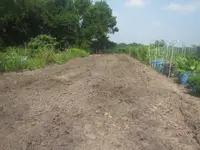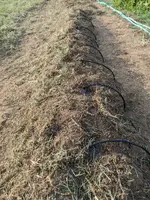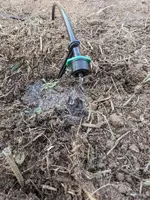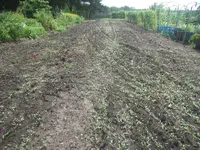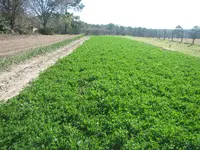So you said this stuff will get up to 10 foot tall? Then what do you do with it? Do you just chop it all down then plow it in?
I'll usually mow it a couple of times and then let it grow to maturity. Chop and drop is the term widely used to describe this soil replenishment technique. At maturity, it tends to get a bit woody in the stalk.
Also, do you have a tractor? I have to do all my work with a plain ol' lawn mower and a tiller, and I know darn well my mower isn't mowing down anything that's 10 foot tall.
Yes, a Kubota compact tractor with about 23 hp. I run a 4ft flail mower behind it. A lawn mower would keep it manageable if you didn't let it get too far ahead of you.
... I was thinking of planting the alfalfa you'd mentioned before in the spot where I'm about to dig potatoes. After that, I'm not sure what I can plant when the squash and other veggies are done because it'll be too late in the year to plant alfalfa around here. It'll just be too darn hot and dry. I do want to do something to add nutrients back to the soil, though, because I'd really like to not have to rely on fertilizer year after year.
Here in East Texas I have found alfalfa to be most useful as a fall/winter/spring cover crop. I usually plant it in fall and disc it in spring. You might find it more suitable for summer for you....just have to find what works best for your climate.
There are many others that can add the nutrients you need. For example, one of the best is cow peas.
From a thread on another forum...I'll try to cut and paste rather than retype:
This thread demonstrates how I use cow peas in a chop and drop process in my garden to organically replenish the soil to the status of “No N-P-K” required without the use of synthetic fertilizers. In summer, the peas have a maturity cycle of just over 60 days making it possible to have multiple crops during a growing season.
The demonstration row, nicknamed @big rockpile, is 75 ft long and was planted in pink eye peas about April 1 this year. On June 3, it was shredded in the first round of chop and drop as shown below.
https://www.gardening-forum.com/attachments/peas-jpg.99229/
The beauty of using cow peas for soil replenishment is that with just one handful of seeds, for well under $5, you can perform this chop and drop multiple times in the growing season without ever having to replant/reseed … if you leave sufficient numbers of mature peas to reseed each cycle. In the photo below, the peas from that initial shredding have germinated and are on their way to a second cycle of chop and drop. Note all the organic matter now in that row.
https://www.gardening-forum.com/attachments/peas-for-big-rock-jpg.99230/
The second cycle progressed into July, once again growing large amounts of great organic matter.
https://www.gardening-forum.com/attachments/sunn-hemp-and-peas-jpg.99231/
By the end of July, they had developed a good stand of matured peas suitable for picking and/or eating. This time, I elected to harvest a small basket full of peas to eat fresh because they are so delicious.
https://www.gardening-forum.com/attachments/bigrock-gen-2-peas-jpg.99232/
As you can see in the photo below, there are still many peas left behind to reseed the third cycle.
https://www.gardening-forum.com/attachments/gen-2-peas-jpg.99233/
You can use a lawn mower or whatever to “chop” or you can do this manually with a machete but that’s hard work in the Texas summer. With a mower, it takes less than 2 minutes to shred the entire 75 ft. row. This leaves a natural seed bed in which the peas left behind will germinate in a matter of days and begin the cycle all over again.
https://www.gardening-forum.com/attachments/shredded-2nd-gen-jpg.99234/
By early October, this third cycle of peas will be mature and can be harvested again and/or you can take a gamble on a fourth cycle which I have done in some years.
In a season with adequate rainfall (which this is not), this process will easily generate over 300 pounds of green organic matter each cycle totaling approximately 13 pounds of organic matter added per foot of row (assuming three cycles).
According to research performed at Texas A&M, the primary pathway for nitrogen transfer from a legume to the soil is through decomposition of dead legume plant material. The root system and unused leaves and stems of the legume decomposes via soil microbes over time. Nitrogen contained in this plant material is released and is available to other plants.
Significant green organic matter added to the soil and natural nitrogen made available for the next planting. …all for less than $5 worth of seed. Nothing I am aware of in gardening can even approach that kind of efficiency/cost ratio.
The third and final generation of cow peas(for this season), all grown from less than $5 worth of seed, needs to be turned under to free up some space for winter crops. They could continue to grow for another month+ and maybe even seed for a fourth generation of peas, but their space is needed for higher priority plants.
It's been a great run of chop and drop and soil building from these plants.
https://www.gardening-forum.com/attachments/cow-peas-third-generation-jpg.99913/


